In this article, we will explore the basics of creating a self-reliant garden that will not only provide you with fresh produce but also contribute to a more sustainable future. Survival gardening is the practice of cultivating your own food to ensure food security and reduce reliance on external sources. By mastering survival gardening basics, you can become more self-sufficient and resilient in the face of uncertain times.
Key Takeaways:
- Survival gardening is the practice of growing your own food for self-reliance and food security.
- By cultivating a self-reliant garden, you can reduce reliance on external sources and contribute to a more sustainable future.
- Survival gardening basics involve understanding your climate, soil type, and available sunlight to choose the right plants.
- Effective planning, preparation, and choosing the right tools are essential for successful survival gardening.
- Creating an ideal growing environment, optimizing soil health, and proper planting and care techniques are critical for a thriving survival garden.
Survival gardening is not just about growing your own food; it is a way to connect with nature, promote self-sufficiency, and contribute to a sustainable future. By incorporating survival gardening basics into your gardening practices, you can create a garden that nourishes both your body and the environment.
Benefits of Survival Gardening
Survival gardening offers a myriad of benefits that go beyond just growing your own food – it can empower you to become self-sufficient and embrace sustainable gardening practices. By cultivating your own self-reliant garden, you not only ensure a steady supply of fresh and nutritious produce, but also contribute to a sustainable future. Let’s explore some essential gardening tips, self-sufficiency gardening, and sustainable gardening techniques that can help you reap the rewards of survival gardening.
Essential Gardening Tips
Starting a survival garden may seem daunting, but with a few simple tips, you can set yourself up for success. Planning is key – consider your climate, soil type, average rainfall, and sunlight exposure to determine the best plants for your garden. Regional reports from organizations like the National Gardening Association can provide valuable information specific to your area.
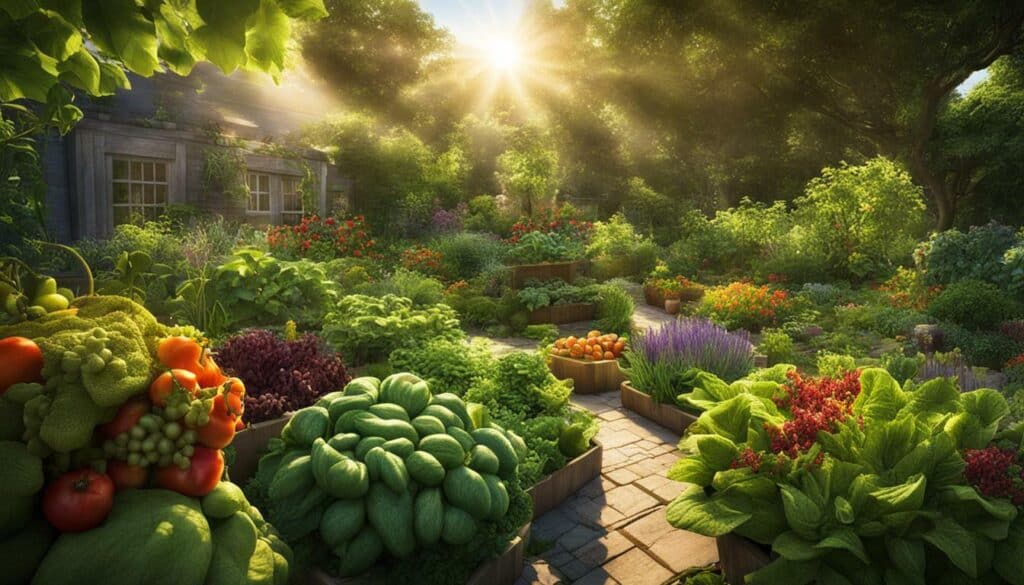
- Choose plants with “cold hardiness” that can withstand winter temperatures in your area.
- Opt for plants with “heat hardiness” if you’ll be growing in high-temperature environments.
- Start with beginner-friendly plants like lettuce, which can be harvested in just over a month, and tomatoes, which provide a bountiful harvest from a single plant.
- Read plant descriptions and tags to ensure plants will thrive in your garden’s conditions.
Self-Sufficiency Gardening
Survival gardening is all about cultivating self-sufficiency and reducing your reliance on external food sources. By growing your own fruits, vegetables, and herbs, you can supplement your grocery budget and have a constant supply of fresh, flavorful produce. Incorporating edibles into your garden, such as string beans, cucumbers, and tomatoes, can help you feed yourself and your family, even in limited spaces like balconies.
“Are you going to feed yourself in a small space by gardening? Probably not. But just having herbs and lettuce that you can cut and constantly come back to, or fresh basil on your windowsill – any bit helps.” – Nick Cutsumpas, Farmer Nick
Sustainable Gardening Techniques
Gardening sustainably is not only beneficial for your plants, but also for the environment. By adopting eco-friendly practices, you can minimize waste, conserve water, and promote biodiversity. Consider incorporating the following sustainable gardening techniques into your survival garden:
- Utilize compost and organic matter to improve soil fertility and structure.
- Choose native plants that are well-adapted to your local environment, reducing the need for excessive watering and chemical inputs.
- Practice integrated pest management, using natural pest control methods like companion planting and beneficial insects.
- Collect rainwater for irrigation to reduce dependence on municipal water sources.
- Minimize the use of synthetic fertilizers and opt for organic alternatives.
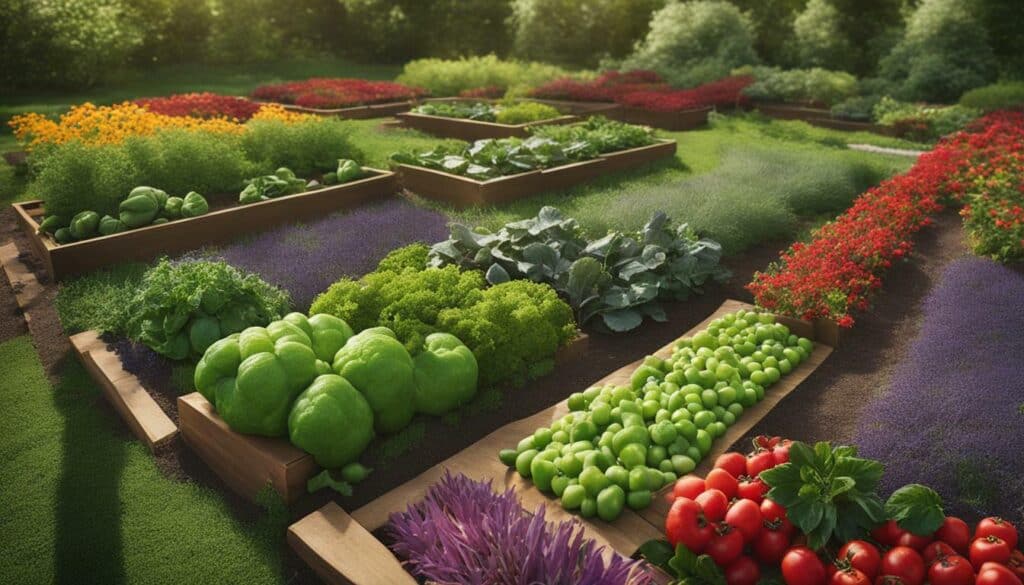
Insects and Diseases
While gardening, it’s important to be aware of common pests, diseases, and disorders that can affect your plants. Learning to identify and manage these issues can help you maintain the health of your survival garden. Stay vigilant and take preventative measures to avoid infestations or disease outbreaks that may compromise your harvest.
Survival gardening not only provides you with fresh and nutritious food but also empowers you to take control of your food security and contribute to a sustainable future. By implementing essential gardening tips, embracing self-sufficiency, and practicing sustainable gardening techniques, you can master your green thumb and enjoy the many benefits of survival gardening.
Growing Food in Small Spaces
Don’t let limited space deter you from creating your own survival garden – even in small areas, you can successfully grow your own food with a few clever techniques. Urban survival gardening is a practical solution for those who have limited backyard space or live in urban environments. In this beginner’s guide to survival gardening, I will provide you with practical advice and tips for growing food in small spaces.
When it comes to urban survival gardening, one of the key considerations is maximizing the use of available space. Regardless of whether you have a small balcony, a rooftop, or just a small patch of land, there are several strategies you can employ to make the most of your space.
Raised beds and containers elevate the garden, making the process easier and allowing you to bring your garden to the backdoor, close to the kitchen for harvesting and cooking,” says Melinda Myers, master gardener and author.
Container gardening is one of the most popular methods for growing food in small spaces. You can use a variety of containers, such as pots, buckets, or even old tires. The key is to ensure that your containers have proper drainage to prevent waterlogging. You can grow a wide range of vegetables, herbs, and fruits in containers, from tomatoes and peppers to lettuce and strawberries. Just make sure to choose varieties that are suitable for container gardening and provide adequate sunlight and regular watering.
Vertical gardening is another effective technique for maximizing space. By growing plants vertically, you can take advantage of unused wall space or utilize trellises, stakes, or hanging baskets to grow climbing plants like cucumbers, beans, and peas. This not only saves valuable ground space but also adds visual interest to your garden.
If you have access to a small amount of land, consider using raised beds. Raised beds are essentially elevated garden beds that provide better control over soil quality and drainage. They are particularly useful for areas with poor soil or limited ground space. You can build raised beds using various materials, such as wood or concrete blocks, and fill them with nutrient-rich soil for optimal plant growth.
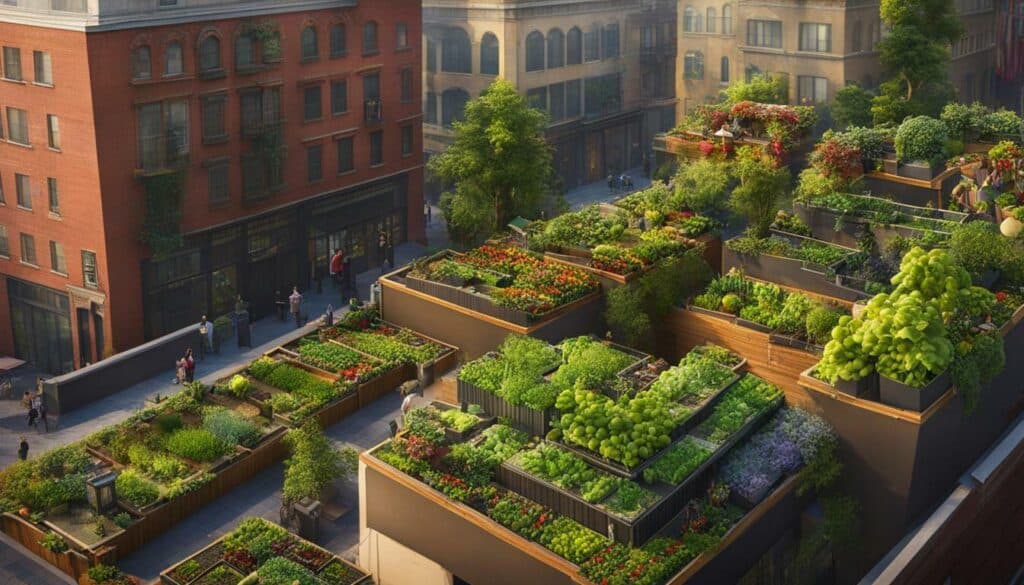
When it comes to plant selection for small space gardening, focus on compact and dwarf varieties that are well-suited to confined areas. Look for plants that are specifically bred for container gardening or have a compact growth habit. This will help ensure that they do not outgrow their allocated space, allowing you to grow a wider variety of plants in a limited area.
Key Takeaways:
- Container gardening is a great option for growing food in small spaces, allowing you to utilize pots, buckets, or other containers for planting.
- Vertical gardening maximizes space by growing plants vertically, utilizing trellises, stakes, or hanging baskets.
- Raised beds are a practical solution for areas with poor soil or limited ground space.
- Choose compact and dwarf varieties that are well-suited to small spaces.
With the right techniques and strategies, you can grow your own food even in the smallest of spaces. Urban survival gardening allows you to take control of your food production and become more self-reliant, even in an urban environment. By implementing these tips, you can create a thriving survival garden and enjoy the fruits of your labor, no matter how limited your space may be.
Selecting the Right Plants for a Thriving Survival Garden
Selecting the right plants is crucial for a thriving survival garden. By embracing organic gardening practices and learning which varieties will provide you with the most nourishing food, you can ensure the success of your garden and enhance your self-reliance. Here are some essential tips to help you choose the right plants for your survival garden:
1. Embrace Organic Gardening
Organic gardening is the practice of growing plants without the use of synthetic chemicals, pesticides, or fertilizers. It promotes the health of both the plants and the soil, contributing to a sustainable and environmentally-friendly garden. When selecting plants for your survival garden, opt for organic varieties that are specifically bred to resist pests and diseases naturally. This will reduce your reliance on chemical interventions and ensure that your food is free from harmful residues.
2. Consider Local Climate and Soil Conditions
It is important to choose plants that are suited to your local climate and soil conditions. Different plants have different temperature and soil requirements, so take the time to research which varieties will thrive in your specific area. Look for plants that are labeled as “cold hardy” or “heat tolerant” to ensure they can withstand the temperature extremes in your region. Additionally, consider getting a soil test kit to determine the pH level and nutrient content of your soil. This information will help you select plants that can thrive in your particular soil conditions.
3. Focus on Nutrient-Dense Foods
When choosing plants for your survival garden, prioritize nutrient-dense foods that will provide you with the essential vitamins and minerals needed for a healthy diet. Leafy greens like spinach, kale, and Swiss chard are rich in antioxidants and are packed with vitamins A, C, and K. Other nutrient-dense options include tomatoes, peppers, carrots, and broccoli. By selecting plants with a high nutritional value, you can ensure that your survival garden provides you with nourishing food during challenging times.
4. Opt for High-Yield Varieties
In a survival garden, maximizing yield is essential. Look for high-yield varieties of plants that produce a large quantity of food per plant. For example, choose tomato varieties that are known for their high fruit production and select zucchini or cucumber varieties that are known for their abundant harvests. By selecting high-yield plants, you can optimize the productivity of your survival garden and increase your food supply.
5. Consider Space and Time Constraints
If you have limited space or are short on time, choose plants that are well-suited for small gardens or require minimal maintenance. Compact plants like cherry tomatoes, dwarf varieties of fruit trees, and container-friendly herbs can thrive in small spaces such as balconies or patios. Similarly, opt for plants that have shorter growing seasons and require less care, such as radishes, lettuce, and beans. By considering space and time constraints, you can create a survival garden that fits your lifestyle and yields maximum results.
6. Seek Local Expertise
When in doubt, seek advice from local gardening experts or join community gardening groups to learn from experienced gardeners in your area. They can provide valuable insight into the best plant varieties for your specific region and offer tips on organic gardening practices. Local nurseries or agricultural extension offices are also excellent resources for finding information on plants that are well-suited to your local climate and soil conditions.
By selecting the right plants for your survival garden and adopting organic gardening practices, you can cultivate a self-reliant garden that provides you with nourishing and sustainable food. Embrace the power of plants and take control of your food security with a thriving survival garden.
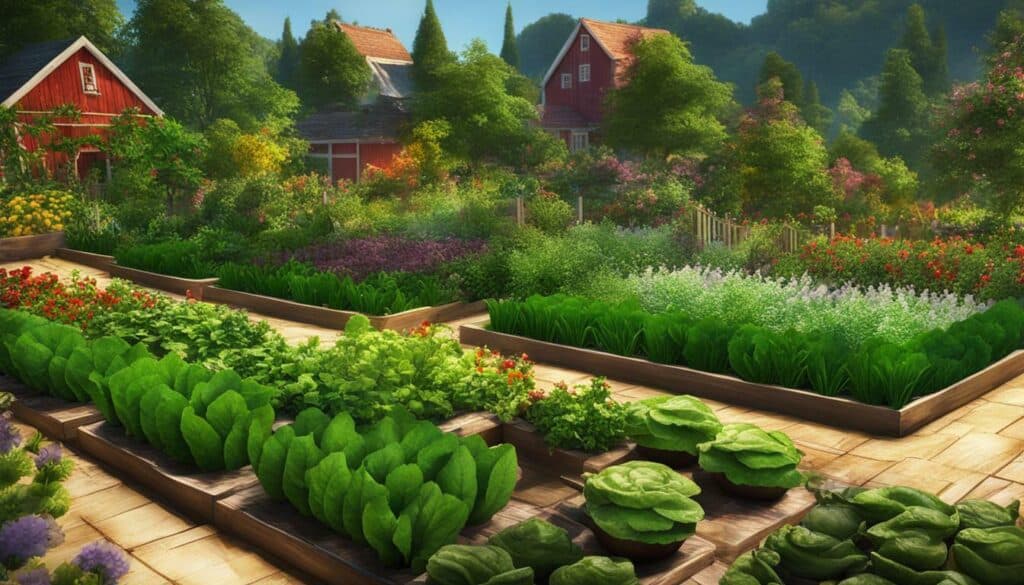
Sources:
- Selecting Plants for Your Vegetable Garden” – University of Illinois Extension
- “Choosing the Right Plants for Your Survival Garden” – The Organic Prepper
- “How to Select the Right Plants for Your Survival Garden” – The Organic Survivalist
Proper Planning and Preparation: Maximizing Food Security through Efficient Garden Design and Proactive Preparation
Proper planning and preparation are essential for a successful survival garden – ensuring food security and self-reliance. By implementing efficient garden design and proactive measures, you can maximize your chances of a bountiful harvest and a sustainable future. Here are some tips to help you get started:
1. Determine Your Garden Space
Before you begin, assess the available space for your survival garden. Whether you have a small urban backyard or limited balcony space, there are ways to make the most of what you have. Consider raised beds, vertical gardening, or even utilizing containers. Adapt your garden to fit your space and make it work for you.
2. Choose the Right Plants
Selecting the right plants for your survival garden is crucial for long-term food security. Consider the climate, soil type, and sunlight exposure of your area. Choose plants that are well-suited to your region and have high nutritional value. Focus on growing a variety of vegetables, herbs, and fruits that can provide a balanced diet.
| Tip: | Opt for heirloom or open-pollinated seeds, as they allow you to save seeds for future planting. |
|---|
3. Prepare and Optimize Your Soil
Healthy soil is the foundation of a thriving survival garden. Conduct a soil test to determine its composition and nutrient levels. Amend the soil with organic matter, such as compost or well-rotted manure, to improve its fertility and drainage. Consider utilizing raised beds or container gardening, which allow for greater control over soil quality.
4. Implement Sustainable Gardening Techniques
Embrace sustainable gardening practices to minimize environmental impact and maximize efficiency. Use organic fertilizers and natural pest control methods to promote healthy plant growth. Practice companion planting to maximize space utilization and deter pests. Consider implementing water-saving techniques, such as mulching and drip irrigation, to conserve water resources.
5. Develop a Comprehensive Garden Plan
Before planting, develop a comprehensive garden plan that includes crop rotation, succession planting, and intercropping. This will help maximize yield and ensure a continuous supply of fresh produce throughout the growing season. Consider the nutritional requirements of different plants and group them accordingly to optimize growth.
| Tip: | Create a planting calendar to help you stay organized and ensure proper timing for sowing, transplanting, and harvesting. |
|---|
6. Take Precautions for Food Security
While gardening offers numerous benefits, it’s essential to take precautions to protect your survival garden. Implement measures to deter pests, such as erecting fences or using natural repellents. Consider investing in protective covers or netting to shield your plants from extreme weather conditions or hungry animals. Regularly monitor your garden for signs of disease or nutrient deficiencies and take prompt action to address any issues.
7. Continual Learning and Adaptation
Gardening is a continuous learning process, so be open to experimentation and adapt your methods as needed. Stay updated on the latest gardening techniques and research, and seek advice from experienced gardeners or local extension offices. By continually improving your skills and knowledge, you can create a thriving survival garden that provides sustenance and security for you and your family.
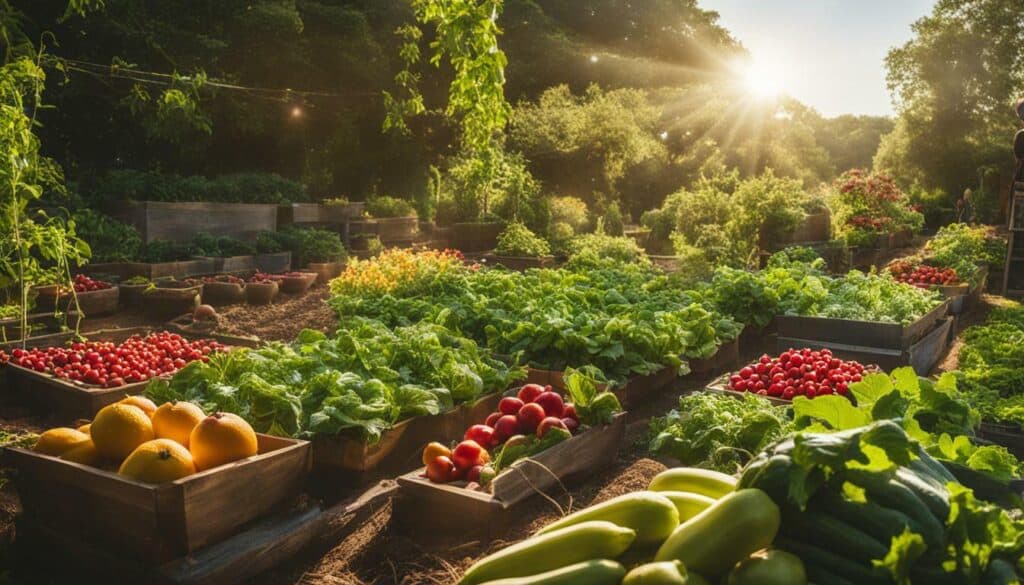
By following these tips and investing time and effort in proper planning and preparation, you can maximize your food security through efficient garden design and proactive measures. Cultivating a self-reliant survival garden not only provides for your immediate needs but also contributes to a sustainable future.
Essential Tools and Equipment
Arm yourself with the essential tools and equipment that will make your survival gardening journey a breeze – from shovels to gloves, we’ll cover everything you need to get started.
When it comes to survival gardening, having the right tools can make all the difference. Here are some essential gardening tools you should have:
| Tool | Description |
|---|---|
| Shovel | A good quality full-size shovel is a must-have for digging into the ground. It’s essential for tasks like turning soil, planting, and transplanting. |
| Hand trowel | A hand trowel is perfect for smaller gardening tasks or for gardening in containers. It’s great for activities like transplanting seedlings, potting plants, and weeding. |
| Bypass pruners | A pair of bypass pruners with two sharp blades that cut like scissors is essential for deadheading, light pruning, and harvesting. It’s a versatile tool that every gardener should have. |
| Hori Hori Knife | A Hori Hori Knife is a handy garden knife that can be used for digging weeds, dividing plants, and other gardening tasks. Its sharp edge and serrated blade make it a versatile tool for various gardening needs. |
| Gloves | A good pair of gloves is essential for protecting your hands while working in the garden. Look for gloves that are durable, comfortable, and provide a good grip. They will not only protect your hands but also provide support, allowing you to work in the garden for longer periods of time. |
These tools will help you tackle a wide range of gardening tasks and make your gardening experience more enjoyable and efficient. Remember, investing in quality tools is worth it as they will last longer and provide better results.
“The one thing every gardener can’t do without is a good shovel.” – Melinda Myers
Having these essential gardening tools at your disposal will equip you to handle various tasks and ensure that your survival garden thrives. With the right tools, you’ll be ready to dig, plant, prune, and harvest your way to a successful garden.
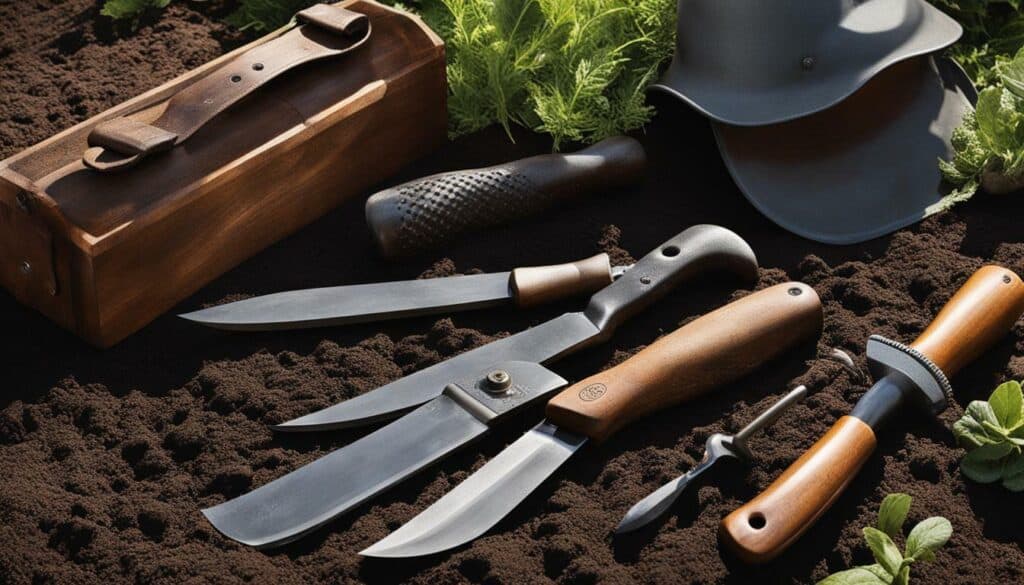
Remember, when using any gardening tools, always follow proper safety guidelines and take precautions to avoid accidents or injuries. Wear protective gear, such as gloves and eye protection, when necessary, and use tools responsibly.
Top Tips:
- Invest in quality tools that are durable and built to last.
- Keep your tools clean and well-maintained to ensure their longevity.
- Consider ergonomic tools that are designed to reduce strain and fatigue during extended periods of use.
- Store your tools properly to prevent rusting and damage.
- Always use tools for their intended purpose and follow proper safety precautions.
By equipping yourself with the essential tools and equipment, you’ll be well-prepared to embark on your survival gardening journey. So, grab your shovel, put on your gloves, and get ready to create a thriving and self-sufficient garden!
Creating an Ideal Growing Environment
Unlock the secrets of creating an ideal growing environment for your survival garden – discover sustainable gardening techniques that will nurture your plants and yield bountiful harvests.
When it comes to survival gardening, creating the right growing environment is essential. By implementing sustainable gardening techniques, you can maximize the health and productivity of your plants. Here are some key tips to help you create an ideal growing environment:
Choose the Right Location
Choosing the right location for your survival garden is crucial. Look for an area that receives full sun for a significant part of the day. Adequate sunlight is essential for the growth and development of your plants. Additionally, ensure that the location has good access to water and quality soil.
Improve Soil Quality
Healthy soil is the foundation of a successful survival garden. Conduct a soil test using a DIY kit from your local garden center to determine its composition and fertility. Depending on the results, you may need to add organic matter such as compost or peat moss to improve drainage and nutrient content. For container gardening, choose a quality planting mix specifically designed for raised beds or pots.
| Benefits of Sustainable Gardening Techniques |
|---|
| Enhanced soil fertility |
| Reduced reliance on synthetic fertilizers |
| Conservation of water resources |
| Promotion of biodiversity |
| Minimization of soil erosion |
By implementing sustainable gardening techniques, you can not only improve the health of your plants but also contribute to the overall well-being of the environment.
Practice Companion Planting
Companion planting involves growing different plants together that benefit each other. For example, planting marigolds alongside tomatoes can help repel pests, while growing beans near corn can improve soil nitrogen levels. By practicing companion planting, you can maximize the use of space in your survival garden and create a harmonious ecosystem.
“Sustainable gardening techniques not only benefit your plants, but also contribute to the well-being of the environment.”
Implement Watering Techniques
Proper watering is essential for the health of your plants. Use watering techniques such as drip irrigation or soaker hoses to deliver water directly to the roots, minimizing water waste. Mulching around your plants can also help retain moisture in the soil and prevent weed growth.
Manage Pests Naturally
Avoid using chemical pesticides and opt for natural pest control methods instead. Beneficial insects, such as ladybugs and lacewings, can help control harmful pests. You can attract these beneficial insects by planting flowers or herbs that they are attracted to. Additionally, practicing crop rotation and proper sanitation can help prevent pest infestations.
By following these sustainable gardening techniques, you can create an ideal growing environment for your survival garden. Not only will your plants thrive, but you’ll also contribute to a healthier and more sustainable future.
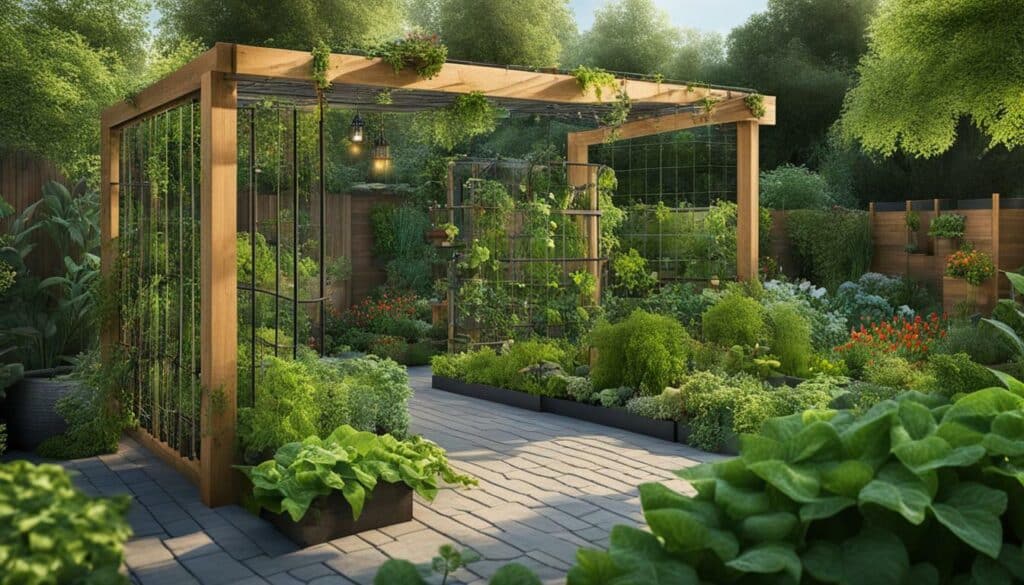
Lay the foundation for a thriving survival garden by mastering soil preparation and fertilization – learn sustainable techniques that will nourish your plants and promote optimal growth.
When it comes to survival gardening, one of the most crucial aspects is soil preparation and fertilization. By ensuring that your soil is healthy and nutrient-rich, you can lay the foundation for a successful and bountiful garden. Incorporating sustainable techniques in your soil preparation and fertilization practices not only benefits your plants but also contributes to a more eco-friendly and sustainable gardening approach.
Soil testing is an essential first step in preparing your survival garden. By understanding the composition of your soil, you can determine its pH level, nutrient content, and any deficiencies that may need to be addressed. You can easily perform a soil test using a DIY kit available at your local garden center. This will help you make informed decisions about the type and quantity of fertilizers or soil amendments needed for optimal plant growth.
Sustainable Soil Amendments
Loading your soil with synthetic fertilizers can have negative consequences on the environment. Instead, opt for sustainable soil amendments that provide essential nutrients while preserving the ecosystem. Organic matter, such as compost, is an excellent choice for improving soil structure and fertility. Compost not only enriches the soil with nutrients but also enhances its water-holding capacity and promotes beneficial microbial activity.
Another sustainable option is using cover crops or green manure. These plants are grown specifically to improve soil health by adding organic matter, preventing erosion, and suppressing weeds. Cover crops, such as legumes or grasses, can be grown during fall or winter and then tilled into the soil before planting your survival garden in spring. This technique not only adds nutrients to the soil but also protects it from erosion and weed growth.
Natural Fertilizers
Avoid synthetic fertilizers and choose natural alternatives that nourish your plants without harming the environment. Organic fertilizers, such as compost tea, fish emulsion, or bone meal, provide a slow-release of nutrients and improve soil structure over time. These natural fertilizers are readily available and can be applied according to the specific nutrient needs of your plants.
When using natural fertilizers, it’s essential to follow the instructions on the packaging and apply them in the correct quantity and timing. Overdosing your plants with fertilizers can lead to nutrient imbalances or environmental pollution. Take a balanced approach and monitor your plants’ growth to determine their nutrient requirements.
The Role of Mulch
Mulching is a sustainable technique that helps conserve moisture, suppress weeds, and maintain an optimal soil temperature. Organic mulches, such as straw, wood chips, or shredded leaves, break down over time, adding organic matter to the soil. Apply a layer of mulch around your plants, ensuring it is thick enough to suppress weed growth but not too thick to suffocate the plants.
| Benefits of Sustainable Soil Preparation and Fertilization |
|---|
| Promotes healthy plant growth |
| Enhances soil fertility and structure |
| Reduces the need for synthetic fertilizers |
| Preserves the environment by minimizing chemical runoff |
| Improves water retention and drainage |
| Encourages beneficial microbial activity |
“Sustainable soil preparation and fertilization techniques not only nourish your plants but also contribute to a healthier and more resilient ecosystem. By focusing on organic matter, natural fertilizers, and mulching, you can create a thriving survival garden while minimizing your environmental impact.”
In conclusion, sustainable soil preparation and fertilization are key components of successful survival gardening. By prioritizing organic matter, natural fertilizers, and mulching, you can create a nutrient-rich environment for your plants to thrive. Remember to perform a soil test, choose sustainable soil amendments, and follow proper application techniques to ensure the health of your survival garden. With these sustainable techniques, you can promote optimal plant growth while contributing to a more eco-friendly and sustainable future.

Planting and Care
Now that you have prepared your garden, it’s time to plant and care for your survival garden – follow these essential tips to ensure your plants thrive and produce an abundant harvest.
Choosing the Right Plants
When selecting plants for your survival garden, it’s important to choose varieties that are well-suited to your climate and growing conditions. Consider the average minimum winter temperatures in your area and choose plants with “cold hardiness.” For areas with hot summers, look for plants with “heat hardiness.” The USDA Cold Hardiness Map and the American Horticultural Society’s Plant Heat Zone Map can help you determine the best plants for your region. Additionally, consult a plant guide or consult with local gardening experts for recommendations.
Planting Techniques
Proper planting techniques are crucial for the success of your survival garden. Start by digging a hole that is deep and wide enough to accommodate the plant’s root system. Gently remove the plant from its container or carefully loosen the roots if it is a bare-root plant. Place the plant in the hole and backfill with soil, making sure to firm it gently around the roots. Water the plant thoroughly after planting to help settle the soil and eliminate any air pockets.
Watering
Watering is an essential aspect of caring for your survival garden. The key is to provide consistent moisture to your plants without overwatering or underwatering. The frequency and amount of water needed will depend on factors such as weather conditions, plant type, and soil moisture levels. Monitor the moisture levels of your soil regularly and water deeply when the top inch of soil feels dry. Avoid wetting the foliage of your plants, as this can promote disease. Consider using soaker hoses or drip irrigation systems to deliver water directly to the plant roots.
Pruning
Pruning is an important maintenance task that helps promote healthy growth and shape your plants. Regular pruning can remove dead or diseased branches, improve air circulation, and encourage the growth of new shoots. Use clean, sharp pruning tools to make clean cuts and minimize the risk of damaging the plant. Be sure to research the specific pruning requirements of the plants in your survival garden, as different plants may have different pruning needs.
Pest Control
Pests can pose a significant threat to your survival garden, but there are several strategies you can employ to keep them at bay. One effective method is to practice companion planting, which involves growing certain plants together to deter pests. For example, planting marigolds can help repel aphids and other insect pests. Natural pest control methods such as handpicking pests, using insecticidal soaps or oils, and attracting beneficial insects can also be effective. Regularly inspect your plants for signs of pests or disease and take appropriate action to prevent and manage infestations.
Quote: “Regular pruning can remove dead or diseased branches, improve air circulation, and encourage the growth of new shoots.”
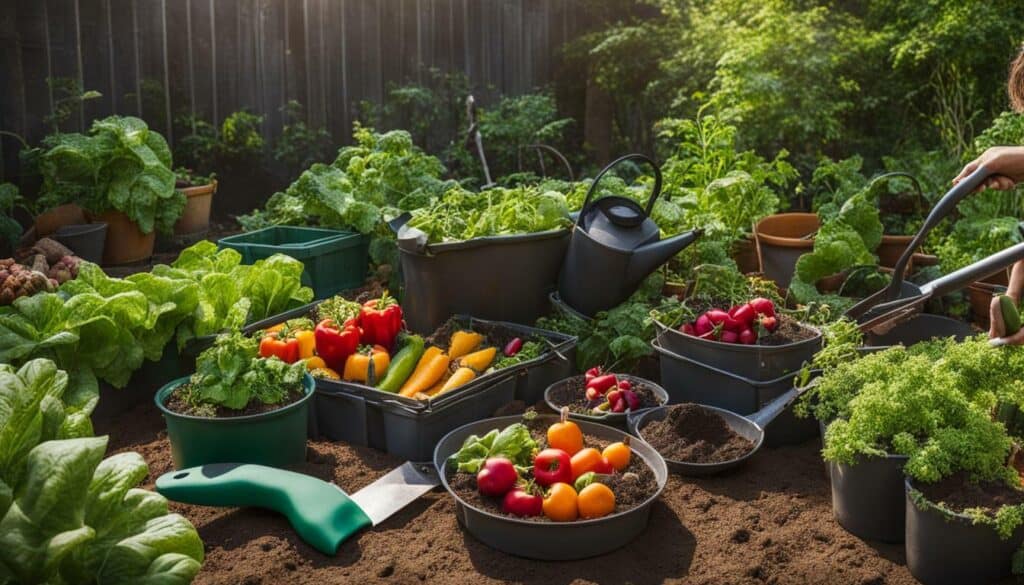
Harvesting
The ultimate reward of your survival garden is the harvest of fresh, nutritious produce. Timing is crucial when it comes to harvesting your crops. Different vegetables and fruits have different maturity times, so consult the seed packet or research the specific requirements of each plant. Harvest leafy greens when they reach the desired size, and pick fruits and vegetables when they are fully ripe. Use sharp gardening shears or a knife to harvest your crops and handle them with care to avoid bruising or damage.
Final Thoughts
Caring for your survival garden requires patience, diligence, and a little bit of knowledge. By following these essential tips for planting and care, you can set yourself up for a successful and bountiful harvest. Remember to stay vigilant against pests and diseases and adapt your practices as necessary. With proper care and attention, your survival garden will provide you with fresh, homegrown food and a sense of self-reliance.
Congratulations on mastering the basics of survival gardening!
By cultivating a self-reliant garden, you are not only ensuring a bountiful harvest but also playing a vital role in creating a sustainable future. Survival gardening is more than just growing your own food; it is a way to become self-sufficient and reduce your reliance on external resources. In this article, we have covered essential tips and techniques for successful survival gardening, including growing food in small spaces, choosing the right plants, planning and preparation, essential tools and equipment, creating an ideal growing environment, soil preparation and fertilization, and proper planting and care.
Benefits of Survival Gardening
Survival gardening offers numerous benefits. It allows you to have access to fresh, nutritious food, reduces your carbon footprint by minimizing transportation and packaging, and enhances your overall well-being through physical activity and time spent in nature. By growing your own food, you can also save money on grocery bills and contribute to food security in your community.
Growing Food in Small Spaces
Don’t let limited space hinder your gardening endeavors. With the right techniques, you can successfully grow food in small spaces such as urban environments or restricted backyard areas. From vertical gardening to container gardening, there are various strategies you can employ to maximize your harvest in constrained spaces.
Choosing the Right Plants
When it comes to survival gardening, choosing the right plants is crucial. Opt for plants that are suitable for your climate and have a high nutritional value. Consider growing a mix of fruits, vegetables, and herbs that are well-suited to your growing conditions. Organic gardening practices can also help you cultivate healthy and pesticide-free produce.
Planning and Preparation
Successful survival gardening starts with careful planning and preparation. Design a garden layout that maximizes your available space and ensures efficient use of resources. Consider factors such as sunlight exposure, water availability, and soil quality. By investing time in planning and preparation, you can set yourself up for a productive and sustainable garden.
Essential Tools and Equipment
To make your survival gardening journey easier and more efficient, it is important to have the right tools and equipment. Invest in quality gardening tools such as shovels, hand trowels, pruning shears, and gloves. These tools will help you with tasks such as digging, planting, pruning, and protecting your plants.
Creating an Ideal Growing Environment
Creating an ideal growing environment is essential for the success of your survival garden. Implement sustainable gardening techniques such as composting, mulching, and natural pest control methods to promote healthy plant growth. Pay attention to factors like soil fertility, irrigation, and proper spacing to optimize your garden’s productivity.
Soil Preparation and Fertilization
Proper soil preparation and fertilization are key to a thriving survival garden. Test your soil to determine its nutrient content and pH levels, and make necessary amendments to ensure optimal conditions for plant growth. Incorporating organic matter and using natural fertilizers can help maintain soil fertility in a sustainable manner.
Planting and Care
When it’s time to plant your survival garden, follow proper planting techniques to give your plants the best start. Pay attention to spacing, depth, and watering requirements for each plant. Regular care, including watering, pruning, and pest control, is essential for the health and productivity of your garden.
Conclusion
Survival gardening is a rewarding and empowering endeavor that allows you to take control of your food supply and contribute to a sustainable future. By following the basics of survival gardening and employing sustainable techniques, you can create a self-reliant garden that provides nourishment, joy, and a sense of accomplishment. Start small, learn from your experiences, and watch your garden flourish as you become a skilled survival gardener.
FAQ
Q: What is survival gardening?
A: Survival gardening refers to the practice of growing your own food as a means of achieving self-sufficiency and preparing for potential challenges or disruptions in the food supply.
Q: Why is survival gardening important?
A: Survival gardening is important because it allows individuals and families to have control over their food sources, promotes self-reliance, and contributes to a more sustainable and resilient future.
Q: Can I grow food in small spaces?
A: Yes, you can absolutely grow food in small spaces. There are many options for gardening in urban environments or limited backyard areas, such as container gardening, vertical gardening, and using raised beds.
Q: How do I choose the right plants for my survival garden?
A: When choosing plants for your survival garden, consider factors such as your local climate, available space, and desired yield. Opt for plants that are well-suited to your region and provide nutritional value.
Q: What tools and equipment do I need for survival gardening?
A: Some essential tools and equipment for survival gardening include a shovel, trowel, watering can or hose, pruners, and gloves. These tools will help you with tasks such as digging, planting, watering, and pruning.
Q: How do I create an ideal growing environment for my survival garden?
A: To create an ideal growing environment, ensure that your garden receives adequate sunlight, has well-draining soil, and is protected from extreme weather conditions. Consider using organic fertilizers and practicing sustainable gardening techniques.
Q: How do I prepare the soil for my survival garden?
A: Soil preparation is crucial for the success of your survival garden. Test your soil for nutrient levels and pH balance, and amend it with organic matter such as compost or manure. This will improve soil structure and fertility.
Q: How do I plant and care for my survival garden?
A: When planting, follow the instructions on seed packets or plant tags regarding spacing, depth, and timing. Provide adequate water, monitor for pests and diseases, and practice regular maintenance tasks such as pruning and weeding.
Q: What are some sustainable gardening techniques I can use?
A: Some sustainable gardening techniques include practicing crop rotation, using natural pest control methods, conserving water through mulching and drip irrigation, and using organic fertilizers. These techniques promote environmental stewardship and reduce the use of chemicals.
Can You Grow Basil in a Survival Garden?
Basil, a hidden gem of gourmet dining, is a versatile herb that thrives in a survival garden. Its vibrant flavor and aromatic qualities can elevate any dish, adding a fresh and earthy twist. From homemade pesto to flavorful marinades, growing basil in your survival garden ensures a constant supply of this culinary delight. Plus, its adaptability and low-maintenance nature make it a perfect choice for beginners and seasoned gardeners alike.

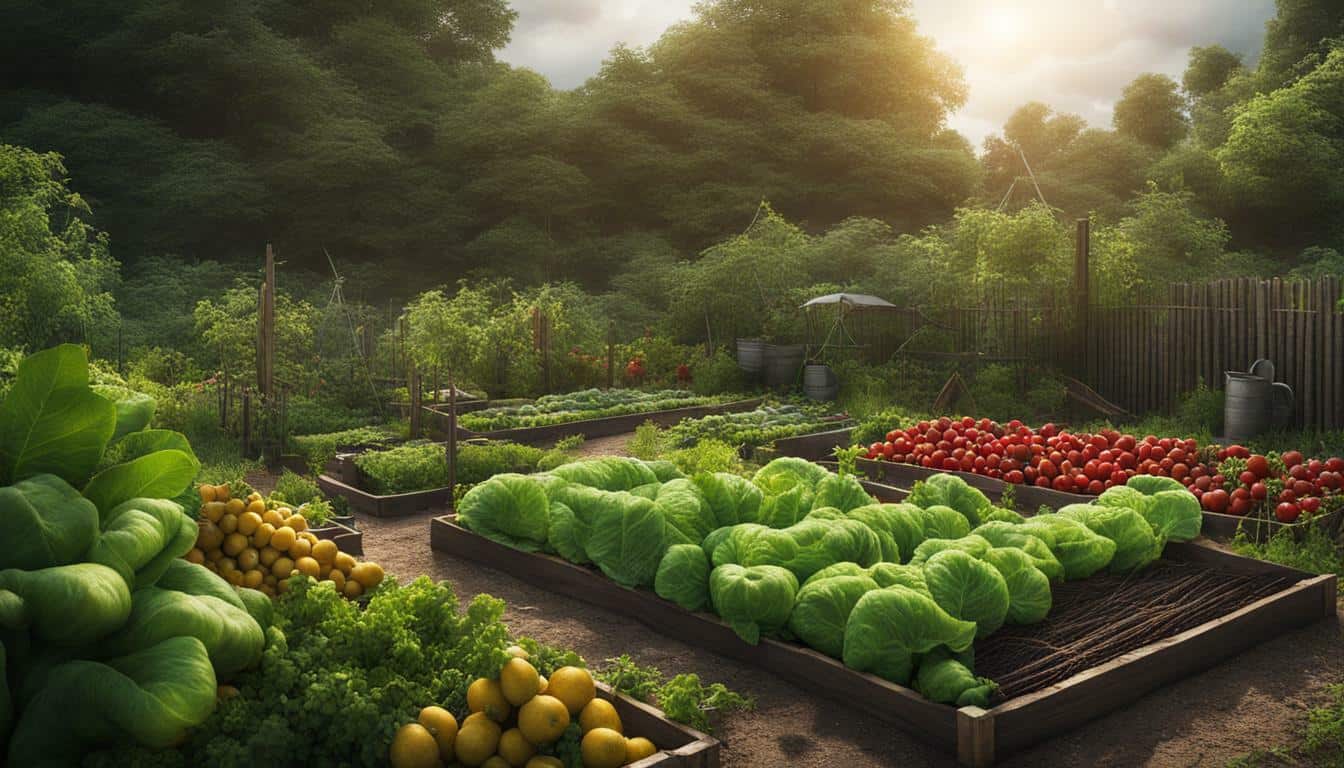



Leave a Reply